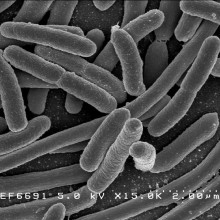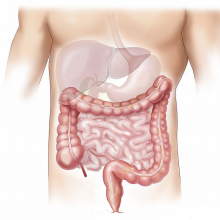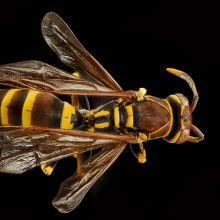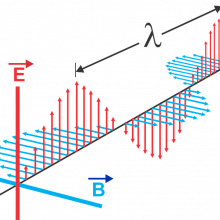Why does dark matter matter?
This week - the mysterious stuff that's passing through you right now, and it literally holds the galaxy together... but we have no idea what it is. We talk to the scientists trying to find out. Plus in the news, the 100 year old technology that’s helping us fight infections we can’t currently treat. And evidence that wasps can size things up...
In this episode

00:60 - Phages treat antibiotic-resistant bacteria
Phages treat antibiotic-resistant bacteria
with Graham Hatfull, University of Pittsburgh
A technology first pioneered about a Century ago - but then largely abandoned with the advent of antibiotics - has received a shot in the arm and saved the life of a patient at Great Ormond Street, thanks to modern technology. This is “phage therapy” - the use of viruses that kill bacteria - to fight infections. Chris Smith spoke to Graham Hatfull from the University of Pittsburgh...
Graham - The headline is we’ve used bacteriophages to treat a patient with an infection with a very nasty antibiotic resistant organism. Colleagues of ours at Great Ormond Street Hospital in London, they had patients that had cystic fibrosis, had a double lung transplant but then had suffered with very serious bacterial infections that became, essentially, untreatable because they were resistant to all of the antibiotics that they could throw at them. And so what we did was to find bacteriophages that infected the very specific bacterial strain that the patient was infected with, that was administered to the patient and we saw really great clinical outcomes and survival of the patient.
Chris - Where did you get the bacteriophage that you ultimately ended up using? How did you go and find it?
Graham - We've been studying these bacteriophages for quite a long time and so we have a library of about 15,000 individual bacteriophages, and from what we know about them we could whittle that down to a shortlist and we were able to identify three phages which worked well against this particular bacterial pathogen.
Chris - And how long did it take you to do that? Because one of the critical things with someone who is extremely unwell is that you don't have much time and if you administer antibiotics that's great because usually you can get them off-the-shelf and give them to the patient straightaway. I'm presuming that you just can't find a phage and turn it round and administer it in the same sort of timeline that you can with an antibiotic at present?
Graham - Yes. It took several months, especially because we not only had to screen amongst our favourite candidates, but we had to do some genetic engineering to take what were rather poor candidates and turn them into being effective antibacterial drugs. These kinds of infections caused by Mycobacteria tend to progress relatively slowly, so in this case we had a period of time - it was six months or so - where the patient was essentially hanging in there, and we were able to get the phages within sufficient time in order to be able to administer them with a good outcome.
Chris - And how did you manipulate the phages to get them so that they would hit the sweet spot, as it were, and take out just the right bacterium?
Graham - So one of the issues we face is that not all of the phages are lytic, they don't always kill when they infect the bacteria. What we needed to do was to go in and use genetic engineering to remove one particular gene which was causing that problem, and thus convert what was really not a very useful phage into being one that was going to be effective therapeutically.
Chris - How did you administer the phages once you'd found the ones that you wanted and you knew you'd optimised them?
Graham - There's really two routes of administration: deliver them intravenously and then some phage solution on gauze was added to both the sternal wound from the transplant as well as onto the skin nodules that appear as a sort of common manifestation of these kinds of diseases.
Chris - And how do you know that you've actually got rid of the bacteria? How do you know that there are not some hiding in there that are now resistant to all known antibiotics and your phage and could come back?
Graham - Again, that's a great question and obviously something that we worry about a lot. Rather than using one phage, we specifically made a cocktail of three phages in order to try to battle that problem of resistance. The bacteria could become resistant against one phage but then they should still be susceptible to the others that we're giving in the cocktail.
Chris - We are in what a UK Chief Medical Officer described as an "antibiotic apocalypse" situation, so do you think there's going to be a big comeback for phages then?
Graham - I think there's a real opportunity to try to find the kinds of infections that phages could really be useful to treat. There are particular types of diseases and infections where they could find a use. And one can imagine using phages in a smart way where you essentially combine them with antibiotics in order to essentially enhance the utility of the antibiotics and to try to help reduce the incidence of resistance to antibiotics.
Graham Hatfull, on how the bacteriophage, first discovered in 1915 by English researcher Frederick Twort, could be set to help us fight antibiotic-resistant infections a hundred years on. Those results were reported in Nature Medicine.

05:57 - Repairing injured lungs for transplantation
Repairing injured lungs for transplantation
with Matthew Bacchetta, Vanderbilt University
Thousands of people die every year waiting on transplant lists. And lungs are in particularly short supply. Now scientists might have found a way to increase the numbers of donor organs that are suitable for transplantation. In experiments using pigs, which have lungs very similar to ours, Matthew Bacchetta from Vanderbuilt University has found that if he takes injured lungs that would normally be unsuitable for transplant, and plumbs them in to a potential recipient’s circulatory system for a day or so - but keeps the lungs outside the body in a special organ chamber - nourished by the healing effects of the blood supply, they recover very rapidly to a state that means they can then be moved inside the recipient. Matthew spoke to Chris Smith...
Matthew - Lungs are extremely sensitive to injury from gastric aspiration, pulmonary contusion, meaning that the lung gets bruised, getting infected while the patient is on a ventilator so they could develop a bacterial infection like pneumonia, and those are the primary reasons that organs are deemed unacceptable for transplantation. The major thrust of what we've done here is replicate the injury that we see in humans. We used what we call a gastric aspiration; what that basically means is that the patient has taken gastric contents, which are very acidic and caustic, into their lungs and it causes inflammation like a severe pneumonia so that the organ cannot be used. And what our system has enabled is the organ to regenerate or repair itself over time.
Chris - How have you done it?
Matthew - We first failed a lot trying different types of ex vivo systems, meaning the organ was placed outside the body separated into a sort of machine perfusion system. And after being very frustrated and failing repeatedly, we eventually sort of had the 'eureka' moment where we said we can't replicate a whole system but what we can do is attach the organ to a natural host or recipient. In other words, the organ could be attached to somebody who needs potentially a lung transplant and that body provides the whole natural system required for wound healing. What we have essentially done is plumbed this organ into the potential recipient who provides all of the critical factors in their blood that enable the organ to heal.
Chris - So where did the lungs sit then, are they in the bath next to what will be the patient? When you actually come do this you’re gonna end up with some tubes coming out of the individual bringing the blood to and from these lungs which are going to be outside their body next to them?
Matthew - That's correct. That's exactly what we do. They are in a specialised container - it actually looks very similar to what we would do for a patient that was on dialysis, they would have blood coming out, it would go into the dialysis machine and then that blood is returned to the patient.
Chris - Does the lung breathe as well as? Are you pushing air in and out of the lungs you do this to keep it natural and what it would be expecting were it inside the body, to create as much a mimic for what the real body environment would be like?
Matthew - It does. We connect it to a mechanical ventilator and we can actually measure the performance of the organ in real time.
Chris - So you're looking at how much oxygen is getting pushed into the blood that your pushing through it by that set of lungs, so that gives you a marker for how well they're behaving and what the improvement is?
Matthew - That's correct, exactly. So we can monitor that over time and that gives us a benchmark to monitor the improvement process and to also let us know when we've reached a level that's normal.
Chris - Why is this better than just putting the lungs into the individual full stop? Because you're basically doing the same thing, you're sending them a blood supply, you're sending them an air supply, why is that better doing it outside body than just putting them in?
Matthew - Yeah, that's a great question. The major difference is that you have to subject the patient to a very invasive procedure. I have to remove their lungs, I have to put in new lungs, and we know that the lungs are damaged, that they're not really acceptable for a transplant. And then I have to support that patient with damaged lungs which causes a profound inflammatory process and so the body actually does not actually work as effectively in healing those lungs and the patient becomes unstable because they're now relying upon an injured organ to keep them alive.
Chris - And how did the recipient fare while they've got this extra set of lungs hitched up to them, and not just any old lungs, someone else's lungs, some other animal's lungs, and diseased lungs at that? Was there an obvious burden on the individual or did they cope well?
Matthew - They actually coped remarkably well. They were hemodynamically stable, meaning that their blood pressure, their heart rate, and all of the other physiologic measures that we use were normal and stable.

12:35 - Predicting Inflammatory Bowel Disease
Predicting Inflammatory Bowel Disease
with Ken Smith, James Lee, University of Cambridge
Inflammatory bowel disease can cause severe pain and serious issues in those who deal with it every day. But what does it mean for those who suffer from it, and how might we improve their lives? Adam Murphy spoke to Ken Smith and James Lee from Cambridge University about a new test they've developed, which can predict the future severity for inflammatory bowel disease in those who suffer with it. But first, we heard from IBD patient Kate, who has been coping with the condition for many years...
Kate - I was diagnosed with Crohn's at 14 and there was no indication that things were going to be so severe in the long run. I was told by my consultant at the time that I would need to have some bowel removed but that there was no reason to think that that wouldn’t be the end of it for a long time. Unfortunately though, within nine months I was unwell again and for the next few years I went through a series of drugs, all of which caused quite serious side effects, but did little to stop the progress of the disease. Eventually, my large bowel became too badly damaged to save and after a few months with a feeding tube to try and get my weight up before surgery, I was told I would need to have a permanent colostomy bag.
Adam - That is Kate. As you heard, she suffers from Crohn's disease, an inflammatory bowel disease or IBD. But what is going on in the bodies people like her? I spoke to James Lee, a gastroenterologist at the University of Cambridge.
James - IBD is an umbrella term. It stands for inflammatory bowel disease and it encompasses Crohn's disease and ulcerative colitis which are two different diseases. But essentially in both diseases what happens is your immune system gets its wires crossed, the immune system actually attacks the bowel, and the result of that is it can cause ulceration and inflammation within the bowel, and that can lead to quite nasty symptoms where you get bleeding and abdominal pain. These are incurable, lifelong diseases and one of the big problems is that some patients will get a very severe and aggressive form of the disease, other people with the same disease can actually have a very mild disease course. And so one of the biggest challenges for treating patients with ulcerative colitis and Crohn's disease right now is identifying which patients need the more aggressive treatment approach because their disease is going to be that much more aggressive, and which patients actually would do very well with relatively minimal therapy.
Adam - And how do you do that? Ken Smith, Head of the Department of Medicine at Cambridge University took me through it...
Ken - We started about 12 years ago. We were interested in working out what factors drove different long-term outcomes for patients with diseases like inflammatory bowel disease. So we started off by recruiting a lot of patients at diagnosis, measuring the expression of genes in their blood at that day, and then comparing the patterns of expression of those genes, so-called signatures, comparing that with their long-term clinical outcomes, so this study's taken many years to do.
What we found was a signature that correlated very strongly with how well people did in the long term. We then took that signature, and in a complex process, developed a test that worked on whole blood that recreated the effect of that signature allowing us to divide patients into two groups that had very different long-term outcomes.
Adam - And the signature you found, what was that?
Ken - It was a signature in things called CD8 T cells, which are a subset of white blood cell, and it essentially was a measure of something that's called T cell exhaustion. So if you have a tendency to have exhausted T cells you tend to have very good long-term outcome, whereas if you don't have exhaustion you have the opposite, you tend to have more aggressive disease course. So we do understand the biological pathways that sort of underpin this observation in this test.
Adam - And what could this mean for patients? Back to James...
James - This could really be a game changer for treating patients with IBD. At the moment, most patients receive what is ostensibly a 'one size fits all' approach to their treatment and that's because we simply haven't had good ways of identifying the patients who need the more aggressive treatment from those who don't. So, at the moment, everybody in the UK and in many other parts of the world will be started on an initial treatment. If their disease continues to flare up frequently, they'll go on to something stronger, and if it continues to flare up they'll go on to something stronger still, and that incremental increase in treatment keeps going until we finally get to the treatment they need.
For the patients who have the most agressive disease that might not be until they get onto their fourth of fifth line treatment and, in the meantime, they've been exposed to sometimes years of persistently active disease with all the risks of the complications that go along with that. Conversely we know that actually if we were able to give the most effective treatments upfront to those sort of patients, those are the patients who stand the most to gain by getting their disease into control early.
So for a long time in inflammatory bowel disease and, for that matter, in other fields of medicine people have been looking for ways to match the right treatment to the right patient, so if you have something that enables you to personalise treatment in that way it could completely change how we treat patients in the future.
Adam - And finally, what could it mean for people like Kate?
Kate - For me, Crohn's has always been a disease that's constantly trying to gain ground. In the years after my diagnosis, failing my way through drugs of varying strength, I lost ground that I might never have had to give up if the people in charge of my care had a tool that allowed them to see a clearer picture of what I needed to stay well. It's incredible to think what a test like this could spare people.

18:05 - Can wasps make comparisons like humans?
Can wasps make comparisons like humans?
with Elizabeth Tibbetts, University of Michigan
Human beings are very talented at using a cognitive skill called “transitive inference” - using information about things you know to draw conclusions about things you don’t know. For example, if you know that A is bigger than B, and B is bigger than C, you can tell that A is bigger than C without having to look at them side by side. We know humans can do this, but it’s something of an open question which other animals can do it as well. Professor Elizabeth Tibbetts from the University of Michigan has been investigating whether one of mankind’s most maligned foes, the wasp, is capable of using this advanced cognitive technique. She spoke to Ben McAllister...
Elizabeth - Long ago people thought that transitive inference was based on logical reasoning and we thought only humans were capable of transitive inference and, not too surprisingly, before long we found that humans were not the only ones. It turns out that a huge range of vertebrates can do transitive inference so primates and birds and even fish.
Ben - Wow. So it lives in that bucket of things that we used to think were kind of unique to the human experience, but we are rapidly learning is becoming a much much smaller bucket?
Elizabeth - It's a very small bucket I think. There had been one study on transitive inference in a non-vertebrate and that was done in honeybees, and they found that bees couldn't do transitive inference. And so I think that wasps are way smarter than bees so I wanted to test whether wasps could do it.
Ben - And for anyone out there who isn't super fond of wasps, you heard it here first, wasps are not only scarier than bees they are indeed infinitely more cunning as well, so add that to your consideration. What did you do with this study specifically in order to figure out if wasps could use transitive inference?
Elizabeth - What we did is we trained them to a bunch of colours. So, for example, we would train them that blue was better than green, and then we would train them the green is better than purple, and then we would train them that purple was better than yellow. So they had all this information and now we asked them to make an inference, so asked them what you like better green or yellow?
Ben - Right. And they've never seen green or yellow together before?
Elizabeth - Exactly. They've never seen green or yellow together. Some of the time green has been good, some of the time green has been bad so there's nothing that should be inherently different about the stimuli.
Ben - How do you go about training a wasp that green is better than say any other colour?
Elizabeth - We train them in this tiny little maize. It has to be tiny because wasps are tiny. Some of the bottom is electrified and then some of the bottom isn't. So when we're training them that blue is better than green, blue is a safe area in the maze and green gives them a little electric shock.
Ben - How exactly do you figure out what's a little electric shock for a wasp?
Elizabeth - I would say it's trial and error. But I promise no wasps were harmed in this experiment. We want them to learn so we don't want them to be freaked out or really worried or anything, right. So we just give them enough shock so that they act a little uncomfortable so they start moving around more quickly and try to get away from it.
Ben - And so they just spend a bit of time in this maze until they eventually land on the part of it that doesn't shock them and that part corresponds to the colour that you want to train them is good?
Elizabeth - Exactly. They move around the maze and they eventually go to the part that's safe and they're like oh my gosh, it's safe and there's the colour green - green is great.
Ben - Okay. What did you do after you trained them?
Elizabeth - After we trained them we had to test them, so we put them in the middle of a box and then we tested which colour they prefer to go to.
Ben - And you had no electric stimuli or was that still present?
Elizabeth - There were colours on either end and there was no electricity to cue them, but the idea is that they've learned that green is good, then they would go to the green side. So we tested them on the colours we had originally trained them on just to confirm that they had learned what we trained them on, and then we also tested them on those new transitive pairs.
Ben - Okay. And what did you find?
Elizabeth - We found that wasps do have transitive inference. So they took all those trained pairs and they seem to kind of organise them in their mind linearly, and then use transitive inference to choose between stimuli that had never been next to each other before.
Ben - That's fascinating because, as you mentioned before, previously someone else had found that bees are incapable of doing this. Surely a bee and a wasp have pretty similar sized brains, right?
Elizabeth - Yeah. Bees and wasps both have similar sized brains and their brains are really tiny, about the size of a grain of rice. I think the difference between bees and wasps isn't really that wasps are just geniuses and bees are dumb, it's more about what the social life of wasps and bees are like. All the workers on a bee colony are about the same, they spend their time foraging, but on a wasp colony there's all sorts of interesting dominance relationships. They have linear dominance hierarchy where the dominant wasp does most of the reproduction and the subordinate wasps do most of the work, and so figuring out how dominant other wasps are in wasp land is incredibly important. For example, if you've beaten Jane in a fight before and you see Jane beat Susan then you can infer hey, I'm probably going to be able to beat Susan. So that kind of thing is really important for wasps and not important for bees.
Ben - I would also say probably important for humans depending on who you ask.
Elizabeth - Yeah, definitely important for humans.
Ben - That's an important thing to know. Do you think there's scope for extending this kind of reasoning to dealing with other animals or other kinds of animal cognition?
Elizabeth - I bet that many other insects are capable of transitive inference. I think we just haven't tested them yet. I think one of the messages is that animals can be really good at what's important to them. We think of humans as being like the best at everything, but lots of animals are amazing at really specific things they need to do to be successful.
Ben - Intelligence doesn't necessarily correlate just the size of the brain but also to the tasks that need to be undertaken?
Elizabeth - Exactly. You don't need a big brain to do complicated things. Even a tiny little brain can do complicated things if the animal needs to be able to do it.

24:03 - In the Naked Scientists mailbox
In the Naked Scientists mailbox
Chris Smith and Katie Haylor opened up the Naked Scientists mailbag to see what listeners have been asking and telling us...
Katie - It turns out that our postman, as he was handing over the mail outside the office the other day, is a fan of the show, so thank you very much. Now he wants to know about gravity. What actually is gravity and what is it made out of? Ben, can you help us out with this one?
Ben - This is a great question. The answer essentially is that we don't know. Nobody really knows which is why it's a great question to be asking. We know there are four fundamental forces in nature and stay tuned to the back half of this program where you'll be hearing about them in a little more detail.
I’ll talk about two specifically; gravity is a force we're talking about here. This is something that exists between any two things that have mass, pulls them together. And we can compare that to another force that we sort of do know what it's made up of which is electromagnetism, this is the force that magnets feel when they attract each other. That force, if you want to say, is made up of something, it's actually made up of these particles called photons which are just little chunks of light. When magnets are attracting they're actually shooting little chunks of light back and forth at each other and that's what that force is made of, if you like.
If we were to bring in analogue to gravity, we don't know if there's something like that with gravity. Some people think there is, there think there might be a particle called the graviton, although this has never been detected. Other people would say there is no thing, it's actually just the physical bending of space-time itself that creates effects that like gravity. So short answer - we don't know. A lot of people are trying to find out - great question.
Katie - It's a big question isn't it?
Ben - Yeah.
Katie - But it sounds like the second half of this show may help us to try and understand some of this science.
Ben - Absolutely. A better understanding of dark matter will certainly lead to a better understanding of gravity.
Katie - So our postman actually picked a very good week to ask about gravity then?
Chris - And there you go. Thank you very much Ben for that first-class answer for our postman

26:40 - What is dark matter?
What is dark matter?
with Professor Lord Martin Rees, Cambridge University
We’re going to be delving into the mysterious stuff that makes up a massive amount of the Universe. But we can’t see it, and we’ve haven’t the foggiest idea what it is. So how are we trying to actually find out, and how do we even know it’s there at all? Ben McAllister has been finding out...
Ben - I'd like to tell you a story. It's a story about galaxies, black holes, stars, planets, people, and everything else in the universe. We now know that all of the big stuff in the universe - people, planets, stars - is made up of a handful of different kinds of particles. These tiny little things like atoms which are made up of protons, neutrons and electrons. We've come to know quite a lot about those little things; how they make up bigger things over the last few hundred years. Collectively, astronomers call all that stuff baryonic matter, and that's kind of all there is, right?
I'm here to tell you that that's not the case. The baryonic matter - people, planets, stars - is only a very small fraction of the whole story. In today's program we're going to hear what we know about the rest of it. We're going to hear about dark matter.
To give you a taste, dark matter is this mysterious stuff that occupies the universe. It's enormous, there's five times as much of it as there is regular matter, it's everywhere. Right now, as you listen it's passing right through your body; we can't see touch or feel it. But before we get to what it is, we have to go back a bit. Have you ever looked at the stars and wondered if there's more out there? If you have, you really aren't alone, humans have been doing it for as long as there gave been humans.
Professor Lord Martin Rees, Astronomer Royal...
Martin - It was actually some of which emerged in the 1930s through the work of Fritz Zwicky, who was a Swiss-American astronomer; and he was studying the distribution of galaxies. Each galaxy is of course as big as our Milky Way, so he was looking at the universe on very large scales. He realised that the galaxies weren't distributed randomly, but they were clusters, and these clusters obviously seem to be held together by gravity. But when he measured the speeds of these galaxies he found it was surprising that they weren't flying apart, because the energy corresponding to those speeds would overwhelm the gravitational force holding the cluster together if that gravity was just due to the galaxies. He inferred that there must be some extra material that bound the cluster together, and this was the first really serious evidence that there was some dark stuff in the universe over and above the gas and stars that are visible.
Ben - For decades we've been observing things like this. Strange movements of large bodies in space that can't be explained if we only consider the matter that we can see. It all comes down to gravity. Gravity is the main force that governs the way things move around in space. It's a force that exists between any two things that have mass and it pulls them together. Gravity gets stronger the more mass there is but importantly, it gets weaker the further apart the two things are.
In space, when we look at the stuff we can see like stars, for example, we can estimate how much mass there is in the system; and then, by using the laws of gravity - what we call Newtonian gravity - we can model the way we expect the mass to move. When things don't move the way we expect, say they move much faster for example, it implies that something's missing from our picture. There's some extra force making things move around faster which points to their being some extra mass to provide that extra force...
Martin - If you had found, for instance, that Jupiter was going round the Sun as fast as the Earth was, you'd have had to infer that there was a lot of mysterious mass outside the Earth's orbit, but inside Jupiter's orbit. So Jupiter was feeling not just the mass of the Sun, but something extra which the Earth wasn't feeling. Something like that, on a far bigger scale of course, happened when people studied the outer parts of galaxies. They found that the material was going round faster, the outlying stars and the gas at large distances was going faster, and this implied that the stars in a galaxy were not the dominant kind of mass, and that a whole, this galaxy like ours was embedded in what came to be called a halo of some material which was not emitting any light but was exerting a strong gravity, and was dominating the gravitational pull in the outer parts of the galaxy.
Ben - We've arrived at the point in the story where, thanks to observations of bodies moving around in space, we're pretty sure we're surrounded by massive amount of dark matter. Again, it's moving through your body right now, and it massively outweighs the regular matter that we understand, we just don't know what it is. We've since figured out a little more about it, but not that much more. It's a new frontier, a new region to explore. We do have some theories to explain the phenomena we see, some of which don't actually include any dark matter at all...
Martin - And there is, of course, the idea that we are wrong about gravity. And of course, all the arguments where you infer a mass from the motions of planets and stars and galaxies: that is assuming, in a sense, Newtonian gravity. So some people are proposing other ways where we wouldn't need to have dark matter at all, and we would simply have a different theory of gravity. But I think most people are against that, because first of all there's no particular reason why we should be surprised by dark matter. There's lots of scope for dark matter particles. And secondly we'd be jettisoning a lot of good data if we abandon the idea that we understood gravity. I would still bet that it's most likely that dark matter is in some kind of particles.
Ben - A number of experiments around the world propose to try and detect these particles as they pass through the earth and we'll hear more about some of those later. But why should we care about this? We can't see, touch or feel it, it's just this mysterious stuff that floats on by...
Martin - Well, we know everyone has gazed up throughout human history at the stars and wondered about them. One of the great achievements of cosmology is to understand the structure of the universe - why there are stars, why there are galaxies, why they are clustered, and the details of that. This is only giving us a consistent story if we have the presence of dark matter which is, on average in the universe, five times as dense as the gas and stars that we see. And I think this success is one of the great achievements of modern science. I would say it's up there with the standard model of particle physics in the genome. When the history of science is written I think the fact that we understand cosmic evolution, and why galaxies exist, is really a very great achievement.
Ben - If that doesn't do it for you, consider this. Think about everything humans have accomplished with an understanding of just one sixth of the matter in the universe. Computers. Modern medicine and spaceflight. All of art literature. Imagine what we could do if we could unlock the rest.

33:20 - How do you model dark matter?
How do you model dark matter?
with Colin DeGraf, Cambridge University
Now, normally, when scientists want to get to grips with how something works, rather like a small child armed with a screwdriver and a toy, we try and take it to pieces. But the problem with dark matter is that, although we can see its effects, we can’t actually detect it or manipulate it. So how can we understand it? One way is to work out what it must be doing by using computer simulations. You tell the computer what dark matter does in some particular way and then ask it to predict how the Universe would look if that were true. And then you can come up with ways to test that theory in the real Universe. Colin DeGraf is a theoretician who does work like this at Cambridge University, and he spoke to Chris Smith...
Colin - Most of what I work with is what's called a cosmological simulation, so we don't try to represent single object in the simulation, instead we're simply modelling a huge volume of space that's representative of a very large amount of the universe. So we’re talking about boxes hundreds of millions of light years across that will include millions of galaxies and we evolved this starting from when the universe was only a few million years old, and we see how this evolves over the course of the entire age of the universe.
Chris - What ingredients do you put into your model in order to see that evolution?
Colin - There are entire different scales of ingredients you want to include. As you just heard, most of the matter in the universe is dark so we only need to include dark matter to be able to do a good job of modelling the large-scale evolution of the universe.
Chris - Your rationale is because this makes up the majority of the mass in the universe, if we just play with that to start with we're not leaving out much.
Colin - Exactly. And as long as you're only looking at the large-scale that's fine, but once you start including the formation of galaxies, the collapse of all this matter into what is comparatively small compared to the superclusters, you start to reach a point where you need to include baryonic matter - the gas, dust and stars, and once you include that it affects how the dark matter collapses as well.
Chris - So you mean your simulations, while they were doing quite a good job, once you start to add the extra things and look slightly more in detail you start to see wrinkles that shouldn't be there, so you know you're missing something?
Colin - Yes, though in some ways it has even been the reverse where you start with dark matter only and then people realise “wait a minute, when you start looking at the dwarf galaxies we're missing some of the dwarf galaxies in the real universe, and the density of the material at the centre of these galaxies doesn't match” so we start having to add extra material into our models.
Chris - Does this begin to constrain ideas about how dark matter must be behaving and what its properties are, because when you make these models in order to get something which is representative of what we see when we gaze out there into deep space at the structure and fabric of the universe, the only way we can explain it is if there are additional properties to dark matter that we currently can't account for?
One of the problems is you can tweak the dark matter model and you can start to better explain some of the small scales at late times, but if you do that and it becomes hard to explain the very early universe. And if you tweak dark matter only to match the early universe then you can't explain what we see now.
Each time you tweak these models you end up changing what you predict to observe in the universe. So by continuously modifying both the dark matter and baryonic or normal matter, we can start to make predictions on how we would expect things to look like in the real universe. And so each one of these models gives us new predictions and then as we have new telescopes and new surveys taking more observations of the universe, we can actually rule some of these models out.
Chris - And what have you been able to exclude? What major predictions have now been able to be laid to rest or put to one side saying no, dark matter definitely doesn't do that, it has to be one of the above?
Colin - Truly ruling something out can be tricky with a simulation but what we can do is make a lot of predictions and so one of the things we look at is how dark matter behaves. The initial simulations we would just assume that the dark matter interacts gravitationally and that's it. Dark matter doesn't collide with itself, there is no other interaction there's just only gravity and that does very well at the large scales, at the small scales it doesn't and so some people will propose that you need warm dark matter instead of cold dark matter.
Chris - And what's the distinction between the two?
Colin - It's essentially just a matter of how massive is a particle of dark matter. Very massive dark matter would be very cold and less massive will be hot, which is the physicists way of saying basically what's the typical speed it's moving at in the early universe. Cold dark matter does a great job of the large scale, hot does not, and we know that the large scale very well and adding normal physics of baryonic material doesn't help. And at the small scales that's where you have a lot of very dense gas and star formation and that's where we really need to do a better job linking both the dark matter and the baryonic physics. And it looks like a lot of the small scale can actually be explained by the normal matter which means our current model strongly suggests that this dark matter particle would be relatively cold.
Chris - You've brought up the idea that dark matter's a particle, would it be reasonable to summarise then saying that the universe is dominated by this mysterious thing, it's some kind of particle, it has a lot of mass because it's very effective at exercising gravity and having a gravitational influence on things, but beyond that we don't actually know anything else about it?
Colin - For the most part, yes. But there have been a lot of different proposed explanations for what this particle could be, some of which you might not even classy as a particle. Initially, people proposed may be they're primordial black holes or they're very old stars, and we have been able to rule those out.
And as we rule these models out better and better, what we're left with is looking like this dark matter should really be explained by what we would consider to be this cold, primarily collisionless, dark matter particle.

38:60 - How much dark matter is there?
How much dark matter is there?
with Ben McAllister
We talk about the dark matter being five times as abundant as regular matter, but that can be a little hard to comprehend. Ben McAllister has prepared a little breather from all this hard science, to help us wrap our minds around it...
Ben - That sound you’re hearing right now, focus on it. Let the loudness of that sound represent the amount of regular matter in the Universe - the stuff that makes people, planets, stars etc. Now, do you hear that low sound slowly fading up? That sound represents the amount of dark matter. Not quite there yet, hang on. There we are. Hear how it swallows up the regular matter? We’re sitting in a sea of this stuff all the time. Let’s just listen for a minute.
Chris - Quite relaxing to listen to! We’re pretty sure dark matter is made of unknown particles that don’t interact with each other, and now we’re going to learn about two of the best candidates for those particles are, and how we’re trying to detect them.

40:08 - What are WIMPs?
What are WIMPs?
with Katherine Freese, University of Michigan
Historically, one popular candidate for dark matter is a particle which, ironically for something that’s actually supposed to be quite hefty, is called a “WIMP”; but don’t be misled: it actually stands for “weakly-interacting massive particle”. And these WIMPs may occasionally be knocking into the atoms in your body, which might help us detect them! Katie Haylor spoke to Katherine Freese from the University of Michigan to learn - what exactly IS a WIMP?
Katherine - There's a lot in that name. If we're right and these are the dark matter particles then there would be billions of them going through you every second. But they're not going to do anything to you because the interactions are really really weak. There are four forces of nature that we know about; there is of course gravity, electromagnetism, the strong force that holds your nuclei together, and the fourth one is the weak force. So we know that WIMPs feel gravity and we know that they don't have anything to do with electromagnetic force because they don't give off light, and the strong force when they bump into you they are not knocking you over so weakly interacting mass of particles means that they have the weak force only in addition to gravity and that they weigh about 1 to 10 thousand times as much as a proton.
Katie - Okay. So why do think that these are the dark matter particles then?
Katherine - One of the reasons that we think WIMPs are such good candidates is because they're automatically there in particle theories that have nothing to do with dark matter. Supersymmetry is an extension of the standard model of particle physics and if you postulate supersymmetry you are automatically get twice the number of particles. For every particle we have today, you have a partner which will be heavier than the particles we know about. And the lightest one of these supersymmetric candidates, that makes a perfect WIMP candidate. And we didn't put it in there to explain the dark matter problem, it automatically comes out of theories that have nothing to do with dark matter. Killing two birds with one stone is a good thing.
Katie - How do we go about trying to detect these particles in the first place if they're so hard to find?
Katherine - The way to look for WIMPs is to look for them scattering off of detectors. You have to put these detectors deep underground to get away from competing signals so you have to go about a mile underground. Some of these detectors are made of giant vats of xenon liquid. Some of the other detectors are made of crystals of very specialised material such as sodium iodide crystals. So deep underneath the mountains you have these detectors sitting there waiting for WIMPs to hit them, and then occasionally you'll get a signal, that's the idea.
Katie - How big are these things?
Katherine - The xenon detectors are a ton in size, you need a ton of material. Even with that, then the expected count rates you'd get one WIMP hitting one xenon nucleus a day. When WIMPs hit the detectors it eventually gives rise to a signal of light and there are specialised tubes that measure when the light hits them. Another thing to look for is when the WIMP hits the detectors they produce phonons; this is sort of like heat travelling through the detector and you look for that heat deposit.
Katie - Have there been any promising results?
Katherine - There is one experiment that has results. This is the DAMA/LIBRA experiment that is made of sodium iodide crystals and it’s sitting under the Apennine mountains outside of Rome. What the DAMA/LIBRA experiment sees is an effect which my collaborators and I predicted back in the 1980s. Because the Earth is going around the Sun, the count rate in the detector should go up and down with the time of year, and this is exactly the kind of signal that DAMA/LIBRA has pulled out of their data and they see it. They now have more than 10 years worth of data and there is absolutely no doubt that they're seeing something modulating, but the question of course is is it dark matter or something else.
Katie - Why would you expect the dark matter signal to vary at different times of year?
Katherine - The count rate on these detectors depends on our speed relative to the WIMPs. That speed is determined by two things: first of all, as the sun moves around the centre of the galaxy we are moving into what you might think of as a wind of WIMPs; it's like when you're driving, it looks like the raindrops are coming into your windshield because you're actually moving into them,so the same thing is true for us. However, on top of that the Earth moves around the sun which means that the speed with which we're moving into the wind of WIMPs changes with the time of year. So when you add those two together then we're moving the fastest into the WIMP wind in June and the slowest in December, so we expect a lot more counts in June than we would get in December.
Katie - Is that what you get in the data then?
Katherine - Well, what they're measuring is the WIMP hits the sodium iodide crystals and then that causes a flash of light, and you can count how many light flashes you get. Now most of them are due to background, to junk that you have to remove but what you're hoping is every now and then one of them is really due to a WIMP. So they count the number of light signals they're getting at all different times of the year - you can see that it goes up and down with the time of year. It exactly matches our predictions which is pretty amazing.
Katie - Are there any potential issues with that because I can imagine there's quite a few things that vary with the different times of year, right? Do you know that it's the WIMPs?
Katherine - That's the problem, we don't know that it's there WIMPs. People, of course, at the beginning proposed many many alternative to WIMPs that could explain the seasonal variations. They thought ah well, it could be the temperature; it could be the atmosphere; it could be muons; it could be all kinds of different things, but it turns out that all of those alternative explanations are just plain wrong. So nobody has any alternative explanation to the WIMPs but the reason we are not all jumping up and down with joy is that when you get this kind of signal you have to repeat it in another experiment, but the vats of xenon are sitting in the same laboratory right next door and they don't see a signal. So what is going on? We have to have more sodium iodide crystals somewhere else on earth to check what is going on with DAMA.
Katie - And is that going on then?
Katherine - Yes it is. There are three experiments looking for it and these three experiments are the Cosine 100 experiment which is based in Korea. There's also another one called Sabre which is a joint Princeton-Australian collaboration, and a third one on in Eise in Spain. So within the next 3 to 5 years we will have an answer; or was DAMA actually seeing WIMPs or was it some noisy signal that we'll never be able to explain?
Katie: Katherine Freese from the University of Michigan.

46:25 - What are axions?
What are axions?
with Gray Rybka, University of Washington/ADMX
This week we’re delving into dark matter and so far we’ve heard about particles called WIMPs that might be what dark matter is made up of. But there are other possibilities too. One is a particle called an axion, and now scientists are developing experiments to try to detect them. Gray Rybka is from the Axion Dark Matter Experiment (ADMX) which is in Seattle, Washington, and claims to be the most sensitive axion dark matter detector on the planet, and he spoke to Chris Smith.
Chris - So Gray, first of all, what's actually wrong with a WIMP?
Gray - What's wrong with WIMPs? Well, I'd rather talk about what's right with axions. It's a particle that was predicted by nuclear physics to solve a very subtle problem, and yet when we look at how many of these axions should be produced in the early universe you get almost exactly the right amount of dark matter. I find that's too good a coincidence, you've got to look for it.
Chris - If I could see an axion what would it look like? How would I recognise one if it came and slapped me round the face?
Gray - An axion is very light and very weakly interacting with anything. If you imagine something like neutrino, it's a thousand times lighter, much less strongly interacting. It's behaviour is much more like a radio wave than even a particle.
Chris - Given that dark matter's all about gravity, if these things are incredibly light does that mean there must be lots and lots of them to subserve enough of an effect then?
Gray - That is absolutely correct. There is a huge, huge number of them.
Chris - And if they're a bit like a sort of radio wave, how are you trying to detect them because we heard from Katherine how she's trying to find WIMPs using their incidental occasional collisions between the WIMP and things like sodium iodide, how do you try and find an axion then?
Gray - Well, the axion should interact very weakly with electromagnetism and that means that if you've got a big strong magnet you can convert axion dark matter into microwaves, and after that you just have to detect the microwaves.
Chris - But I thought the whole point of this was that we thought dark matter doesn't really interact with anything?
Gray - Well, it interacts very, very weakly. You need an extremely strong magnet and to see the signal, which is in the yoctowatts, “yocto” being the bottom of the SI units scale, you need both an extremely sensitive detector and you need very very low noise levels. The thing has to be cooled to a 100 millikelvin just to keep the blackbody radiation from making it impossible to see the signal.
Chris - Talk us through actually how your detector works then, so where is it built how does it work, and what does it do when it registers a hit? How will you know when you found in axion or two coming through?
Gray - It's at the University of Washington and the outside is an 8 Tesla superconducting magnet with maybe a 50 cm bore, about a metre deep of active area. Inside that we have a big tin can, well it's a copper can, and we can tune the frequency that that can resonates at, we can tune what microwave photons it picks up, and as we tune that sweeping across frequencies, if we hit the frequency that corresponds to the axion mass it will start ringing up. And so we'll see extra power coming just out of the dark matter, and we pick that up with what's essentially a very very fancy AM radio.
Chris - Does that mean then that when they're in this intense magnetic field being resonated at the right frequency, it's actually the particles or the waves themselves the axions that are moving backwards and forwards in generating that signal that you are detecting?
Gray - Yeah, that's absolutely right. You can view it as the axions are turning into microwave photons or you can view it as just an interaction between the axion waves and radio waves.
Chris - Actually how close are you to being able to detect what you think is a real axion now because, obviously, there are sensitivities with all these experiments? And I mentioned at the beginning that you are laying claim to having the most sensitive way of doing this, so how sensitive is sensitive?
Gray - Well, this is the exciting part. After decades of work we finally have an experiment that is sensitive to the theoretically predicted axion interactions, which means now we're operating just any day as we slowly tune this radio like experiment we could make a discovery.
Chris - Will there be a repetition of this experiment because are other people also building similar detectors because obviously it's important to do replication, isn't it?
Gray - There are a number of people who are working on detectors, mostly they're working on ways of making them more sensitive. There's kind of an interesting thing about axions which is that once you know the exact frequency to look at it’s much easier to build an experiment. So once we've made a discovery, I think that very quickly, all over the world there will be people who will be able to build experiments, repeat the signal, see that yes we see this all over the world and start doing some axion astronomy with it.
Chris - And how does this tally with what Colin was saying about his modelling? If you actually feed in axions into models like Colin's do they actually fit the bill?
Gray - Yes. That's kind of the interesting thing is there are people working very hard to say ‘Is there a difference between axions and WIMPs and what we would see astrophysically?’ So far the answer is no but there's always hoping that more subtle models will be able to fish out the difference.
Chris - And is there any grounds for considering that they might actually be more than one particle, because you're in the axion camp, we heard from Katherine in the WIMP camp, is it possible that more than one thing is happening at once?
Gray - It's certainly possible. Nature can be very very rich. Just Occam’s Razor that we hope that it's just one thing. If it is many things that's great, it'll keep us physicists in business for quite a while.

53:12 - QotW: How long ago was my breath my dinner?
QotW: How long ago was my breath my dinner?
Fred - When we eat and drink, the macronutrients (the carbohydrate, protein and fat) in our food are digested in our stomach and small intestine to produce glucose, amino acids and fatty acids, which are transported across the wall of our intestines and into the blood stream. Anything which doesn’t get digested enters into our colon, where it is fermented by the bacteria which live there to produce short chain fatty acids, which are also absorbed into our blood stream.
Ruby - So our food gets broken down into its building blocks, which then get sent around our body for a range of different uses.
Fred - After entering the blood stream, some of the nutrients are stored as fat or glycogen
Ruby - Glycogen is a big sugar which our body uses to store glucose.
Fred - A proportion is used to build and maintain our bodies, and the rest are respired for energy. During respiration, our cells convert nutrients into water and carbon dioxide, releasing the energy for us to live. The carbon dioxide is then excreted in our breath - so a proportion of the carbon from our food ends up as carbon dioxide in our breath.
Ruby - As hal C pointed out on our forum, nutrients that are stored as fat might be in our bodies for a long, long time before they eventually get used, so let’s focus on the food that goes straight into energy production. How can we measure how long it takes? How can I know if an atom of carbon I just breathed out came from lunch today, or breakfast yesterday?
Fred - For plant-based foods it is possible to label the carbon in the macronutrients, using a harmless, naturally occurring, non-radioactive isotope of carbon; carbon thirteen. We do this with colleagues at the University of Glasgow by growing the plants in a greenhouse which has labelled carbon dioxide gas pumped into it.
Ruby - Plants can do the reverse of what we do - they take in carbon dioxide, and build it up into carbohydrates. If they’re surrounded by labelled carbon dioxide, then everything they make from it will also be labelled. And if you make those plants into food, and feed it to people, you have a way to track the carbon from that specific meal.
Fred - Then we can take breath samples and use a very sensitive instrument called an isotope ratio mass spectrometer to measure the amount of labelled carbon thirteen in our breath.
Ruby - Thank you to the good people who ate in the name of science. And what is the answer to Greg’s question? How long does it take for that labelled carbon to be exhaled?
Fred - We can identify two peaks of carbon excreted in breath following eating a food. The first peak, around 2-4 hours after eating, comes from the food which is digested in the upper digestive tract being respired. The second peak, from 4-8 hours, is from short chain fatty acids produced by bacteria in the colon.










Comments
Add a comment